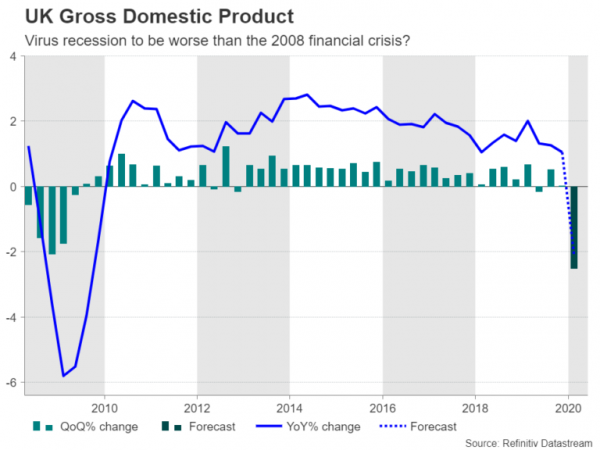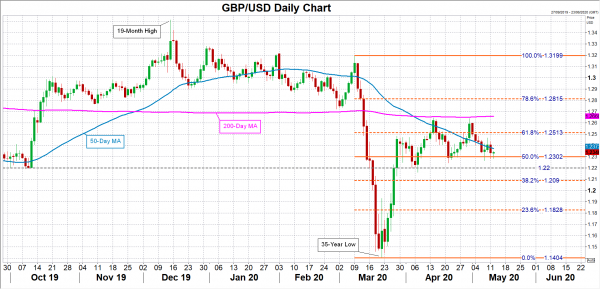It will be the UK’s turn next to post dire economic output figures as the coronavirus leaves no country spared. First quarter GDP estimates are due on Wednesday (06:00 GMT) and they will likely only be a taste of what to expect in the second quarter. With Britain resisting the urge to relax social distancing measures too significantly, the economic costs of containing the virus outbreak are mounting, clouding the outlook for the pound.
Q1 GDP drop just the beginning
The United Kingdom did not impose a mandatory stay-at-home order until March 23, but with the economy overdependent on the services sector and already struggling from the Brexit mess, gross domestic product (GDP) is expected to have taken a major hit in Q1. Forecasts are for total economic output to have tumbled by 2.5% over the quarter to March. On a yearly basis, GDP is estimated to have fallen by 2.1% – the largest annual contraction since the 2008/09 financial crisis.
In March alone, the dominant services sector is expected to have shrunk by a colossal 8% month-on-month. Industrial output is also anticipated to have slumped, albeit at a somewhat more moderate 5.6% rate. The only positive in Wednesday’s data is likely to be found in the March trade figures, as Britain’s trade gap with the rest of the world is projected to have narrowed as consumers were forced to stay away from non-essential stores, meaning fewer goods were imported.
More QE likely by Bank of England
If the headline GDP figure falls short of the already gloomy forecast, it is bound to add pressure on both the government and the Bank of England to inject further cash into the economy. The BoE restarted its bond buying program in March in response to the virus crisis and most analysts think further easing is on the cards in June despite policymakers standing pat at last week’s meeting.
The Bank’s quantitative easing (QE) program is one of the most aggressive in the latest wave of central bank easing around the world and at the current rate of purchases, the BoE looks set to achieve its target of £200 billion sometime in early July. Hence, the odds that the size of QE will be boosted at the next meeting are very high and a weaker-than-expected GDP report would reinforce this.
Pound support at $1.23 looking shaky
The pound would be at risk of slipping back below the key $1.23 mark if Wednesday’s numbers provide little to be optimistic about. The $1.23 level is the 50% Fibonacci retracement of the March down move and breaching it would open the way for the 38.2% Fibonacci of $1.2090.
Upward attempts are possible if the data reveals the economic toll from the virus wasn’t quite so dramatic in the first quarter. But the pound is currently being capped by its 50-day moving average so a convincing push above it would likely have to coincide with broader risk-on sentiment in the markets, and this would then clear the path for the 61.8% Fibonacci of $1.2513.
Johnson’s virus policies sending mixed messages
Beyond the GDP data and aside from BoE policy, politics will probably play an important role in determining the pound’s fortunes during the pandemic as Boris Johnson’s handling of the UK’s response continues to come under scrutiny. After initially being sceptical about introducing a lockdown, Johnson now appears to be taking a more cautious approach than his counterparts in Europe and the United States in lifting the restrictions.
This potentially means businesses in the UK will remain shut for longer than in most other countries, and while the government’s fiscal package to support the economy has been impressive, there has been lack of clarity about its health advice to the public. Confusing government guidelines have raised doubts about how strictly the lockdown measures are being followed by the public, raising the prospect of a prolonged partial shutdown of the UK economy and a much longer lasting impact of the virus.














